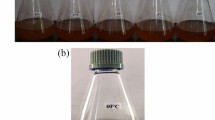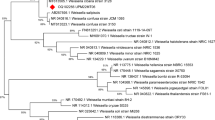Abstract
The present study was conducted to biosynthesize zinc oxide nanoparticles (ZnONPs) by an estuarine associated actinobacterium Streptomyces spp., characterized its spectral features and also determined its biomedical properties. At first, ZnONPs were synthesized by actinobacterial-mediated reduction of zinc oxide metal and then, it was characterized by following standard methodologies. The biosynthesized ZnONPs were confirmed through the reduction of Zn ions with the strong intensity range (3 eV) at zinc region and the absorption range of 363 nm. The XRD pattern of biosynthesized ZnONPs showed six intensive peaks with 2θ values of 36.38–83.34º. This ZnONPs exhibited spherical in shape with the average size ranges in between 51.42 and 65.13 nm. The antimicrobial efficacy of various concentrations of ZnONPs was determined against both bacterial and fungal pathogens and it revealed the highest growth inhibition against E. coli (22 mm) at 20 μl concentration with the respective MIC and MBC values of 0.625 μg/ml and ≤ 2.5 μg/ml. Similarly, the antifungal activity represented the maximum (20 mm) zone of growth inhibition against Candida fructus at 20 μl concentration. Furthermore, the in vitro antioxidant, anti-inflammatory and antibiofilm efficiency of ZnONPs were tested. The result inferred that the maximum in vitro total antioxidant activity (70.86%), DPPH (79.26%), nitric oxide (67.31%) and hydroxyl radical (76.83%) scavenging activities were noted at 125 μg/ml concentration of ZnONPs with the respective half maximal inhibitory concentration (IC50) values of 81.69, 83.42, 76.09 and 82.46 μg/ml. In in vitro anti-inflammatory activity study, the maximum concentration (500 μg/ml) of ZnONPs showed the inhibition of 94.62% with the IC50 value of 146.70 μg/ml. Finally, the ZnONPs effectively reduced the biofilm formation with the highest percentage (91.08%) of inhibition against E. coli at 75 μg/ml concentration. Based on these results, it could be concluded that the actinobacterium Streptomyces spp., mediated biosynthesized ZnONPs has biomedical potential with antimicrobial, antioxidant, antiinflammatory and antibiofilm properties.








Similar content being viewed by others
References
Abbasi BA, Iqbal J, Ahmad R, Zia L, Kanwal S, Mahmood T, Wang C, Chen JT (2020) Bioactivities of Geranium wallichianum leaf extracts conjugated with zinc oxide nanoparticles. Biomolecules 10:1–19
Abdelhakim HK, El-Sayed R, Rashidi FB (2020) Biosynthesis of zinc oxide nanoparticles with antimicrobial, anticancer, antioxidant and photocatalytic activities by the endophytic Alternaria tenuissima. J Appl Microbiol 128:1634–1646
Abd-Elnaby HM, Abo-Elala GM, Abdel-Raouf UM, Hamed MM (2016) Antibacterial and anticancer activity of extracellular synthesized silver nanoparticles from marine Streptomyces rochei MHM13. Egypt J Aquat Res 42:301–312
Abdul H, Sivaraj R, Venckatesh R (2014) Green synthesis and characterization of zinc oxide nanoparticles from Ocimum basilicum L. var. purpurascens Benth.- lamiaceae leaf extract. Mater Lett 131:16–18
Albukhaty S, Al-Karagoly H, Dragh MA (2020) Synthesis of zinc oxide nanoparticles and evaluated its activity against bacterial isolates. J Biotech Res 11:47–53
Al-Kordy MH, Sabry SA, Mabrouk MEM (2020) Photocatalytic and antimicrobial activity of zinc oxide nanoparticles synthesized by halophilic Alkalibacillus sp. w7 isolated from a Salt Lake Hend. Egypt J Aquat Biol Fish 24:43–56
Bala N, Saha S, Chakraborty M, Maiti M, Das S, Basu R, Nandy P (2015) Green synthesis of zinc oxide nanoparticles using Hibiscus subdariffa leaf extract: effect of temperature on synthesis, anti-bacterial activity and anti-diabetic activity. RSC Adv 5:4993–5003
Balagurunathan R, Radhakrishnan M, Rajendran RB, Velmurugan D (2011) Biosynthesis of gold nanoparticles by actinomycetes Streptomyces viridogens strain HM10. Indian J Biochem Biophys 48:331–335
Balraj B, Senthilkumar N, Siva C, Krithikadevi R, Julie A, Vetha Potheher I, Arulmozhi M (2017) Synthesis and characterization of zinc oxide nanoparticles using marine Streptomyces sp. with its investigations on anticancer and antibacterial activity. Res Chem Intermed 43:2367–2376
Dobrucka R, Długaszewska J (2016) Biosynthesis and antibacterial activity of ZnO nanoparticles using Trifolium pratense flower extract. Saudi J Biol Sci 23:517–523
Duran N, Marcato PD, Alves OL, De Souza GH, Esposito E (2005) Mechanistic aspects of biosynthesis of silver nanoparticles by several Fusarium oxysporum strains. J Nanobiotechnol 3:1–8
Faisal S, Jan H, Ali Shah S, Shah S, Khan A, Akbar MT, Rizwan M, Akhtar N, Khattak A, Syed S (2021) Green synthesis of zinc oxide (ZnO) nanoparticles using aqueous fruit extracts of Myristica fragrans: Their characterizations and biological and environmental applications. ACS Omega 6:9709–9722
Garza-Cervantes A, González EE, Castro EDB, Garza MG, Cancino BAM, Vázquez MAL, Ramirez JRM (2019) Antimicrobial and antibiofilm activity of biopolymer-Ni, Zn nanoparticle biocomposites synthesized using R. mucilaginosa UANL-001L exopolysaccharide as a capping agent. Int J Nanomed 14:2557–2571
Govindappa M, Farheen H, Chandrappa CP, Rai RV, Raghavendra VB (2016) Mycosynthesis of silver nanoparticles using extract of endophytic fungi, Penicillium species of Glycosmis mauritiana, and its antioxidant, antimicrobial, anti-inflammatory and tyrokinase inhibitory activity. Adv Nat Sci Nanosci Nanotechnol 7:1–9
Jesline A, John NP, Narayanan PM, Vani C, Murugan S (2015) Antimicrobial activity of zinc and titanium dioxide nanoparticles against biofilm-producing methicillin resistant Staphylococcus aureus. Appl Nanosci 5:157–162
Kalaba MH, Moghannem SA, El-Hawary AS, Radwan AA, Sharaf MH, Shaban AS (2021) Green synthesized ZnO nanoparticles mediated by Streptomyces plicatus: Characterizations, antimicrobial and nematicidal activities and cytogenetic effects. Plants 10:1–26
Kalpana VN, Sirish Kataru BA, Sravani N, Vigneshwari T, Panneerselvam A, Devi Rajeswari V (2018) Biosynthesis of zinc oxide nanoparticles using culture filtrates of Aspergillus niger: Antimicrobial textiles and dye degradation studies. Open Nano 3:48–55
Kemung HM, Tan LTH, Chan KG, Ser HL, Law JW, Lee LH, Goh BH (2020) Streptomyces sp. strain MUSC 125 from mangrove soil in Malaysia with anti-MRSA, anti-biofilm and antioxidant activities. Molecules 25:1–20
Kundu D, Hazra C, Chatterjee A, Chaudhari A, Mishra S (2014) Extracellular biosynthesis of zinc oxide nanoparticles using Rhodococcus pyridinivorans NT2: multifunctional textile finishing, biosafety evaluation and in vitro drug delivery in colon carcinoma. J Photochem Photobiol B 140:194–204
Lingaraju K, Raja Naika H, Manjunath K, Basavaraj RB, Nagabhushana H, Nagaraju G, Suresh D (2016) Biogenic synthesis of zinc oxide nanoparticles using Ruta graveolens (L.) and their antibacterial and antioxidant activities. Appl Nanosci 6:703–710
Mahamunia PP, Patila PM, Dhanavadeb MJ, Badigerc MV, Shadijaa PG, Boharaa RA (2019) Synthesis and characterization of zinc oxide nanoparticles by using polyol chemistry for their antimicrobial and antibiofilm activity. Biochem Biophys Rep 17:71–80
Markus J, Mathiyalagan R, Kim YJ, Abbai R, Singh P, Perez ZEJ, Hurh J, Yang DC (2016) Intracellular synthesis of gold nanoparticles with antioxidant activity by probiotic Lactobacillus kimchicus DCY51 isolated from Korean kimchi. Enzyme Microb Technol 95:85–93
Mizushima Y, Kobayashi M (1968) Interaction of antiinflammatory drugs with serum proteins, especially with some biologically active proteins. J Pharm Pharmacol 20:169–173
Moghaddam AB, Moniri M, Azizi S, Abdul Rahim R, Ariff AB, Saad WZ, Mohamad R (2017) Biosynthesis of ZnO nanoparticles by a new Pichia kudriavzevii yeast strain and evaluation of their antimicrobial and antioxidant activities. Molecules 22:1–18
Nagajyothi PC, Cha S, Yang IJ, Sreekanth TVM, Kim KJ, Shin HM (2015) Antioxidant and anti-inflammatory activities of zinc oxidenanoparticles synthesized using Polygala tenuifolia root extract. J Photochem Photobiol B 146:10–17
Pick E, Mizel D (1981) Rapid microassays for the measurement of superoxide and hydrogen peroxide production by macrophages in culture using an automatic enzyme immunoassay reader. J Immunol Methods 46(2):211–226
Rajivgandhi G, Maruthupandy M, Muneeswaran T, Anand M, Manoharan N (2018) Antibiofilm activity of zinc oxide nanosheets (ZnONSs) using Nocardiopsis sp. GRG1 (KT235640) against MDR strains of gram negative Proteus mirabilis and Escherichia coli. Process Biochem 67:8–18
Ritika C, Reddy A, Abraham J (2015) Biosynthesis of silver and zinc oxide nanoparticles using Pichia fermentans JA2 and their antimicrobial property. Appl Nanosci 5:63–71
Sanjivkumar M, Brindhashini A, Deivakumari M, Palavesam A, Immanuel G (2018) Investigation on saccharification and bioethanol production from pretreated agro-residues using a mangrove associated actinobacterium Streptomyces variabilis. Waste Biomass Valor 9:969–984
Sanjivkumar M, Vaishnavi R, Neelakannan M, Kannan D, Silambarasan T, Immanuel G (2019) Investigation on characterization and biomedical properties of silver nanoparticles synthesized by an actinobacterium Streptomyces olivaceus (MSU3). Biocatal Agric Biotechnol 17:151–159
Sanjivkumar M, Vijayalakshmi K, Silambarasan T, Sholkamy EN, Immanuel G (2020) Biosynthesis, statistical optimization and molecular modeling of chitinase from crab shell wastes by a mangrove associated actinobacterium Streptomyces olivaceus (MSU3) using Box-Behnken design and its antifungal effects. Bioresour Technol Rep 11:1–15
Santhoshkumar J, Venkat Kumar S, Rajeshkumar S (2017) Synthesis of zinc oxide nanoparticles using plant leaf extract against urinary tract infection pathogen. Resour Efficient Technol 3:459–465
Shaaban M, El-Mahdy AM (2018) Biosynthesis of Ag, Se, and ZnO nanoparticles with antimicrobial activities against resistant pathogens using waste isolate Streptomyces enissocaesilis. IET Nanobiotechnol 12:741–747
Shanmugasundaram T, Balagurunathan R (2017) Bio-medically active zinc oxide nanoparticles synthesized by using extremophilic actinobacterium, Streptomyces sp. (MA30) and its characterization. Artif Cell Nanomed Biotechnol 45:1521–1529
Singh K, Kumar Y, Puri P, Sharma C, Aneja KR (2013) Antimicrobial, spectral and thermal studies of divalent cobalt, nickel, copper and zinc complexes with triazole schiff bases. Arab J Chem 10:S978–S987
Sousa A, Ferreira ICFR, Barros L, Bento A, Pereira JA (2008) Effect of solvent and extraction temperatures on the antioxidant potential of traditional stoned table olives ‘“alcaparras.”’ Food Sci Technol 41:739–745
Stepanovic S, Cirkovic I, Ranin L, Svabic-Vlahovic M (2004) Biofilm formation by Salmonella sp. and Listeria monocytogenes on plastic surface. Lett Appl Microbiol 38:428–432
Tabrez S, Musarrat J, Al-khedhairy AA (2016) Colloids and surfaces B: biointerfaces countering drug resistance, infectious diseases, and sepsis using metal and metal oxides nanoparticles: current status. Colloids Surf B 146:70–83
Acknowledgements
The authors are gratefully acknowledge the management and the Principal of K.R. College for their moral support.
Author information
Authors and Affiliations
Corresponding author
Ethics declarations
Conflict of interest
The authors declared that there is no conflict of interest.
Additional information
Communicated by Yusuf Akhter.
Publisher's Note
Springer Nature remains neutral with regard to jurisdictional claims in published maps and institutional affiliations.
Rights and permissions
About this article
Cite this article
Sanjivkumar, M., Silambarasan, T., Ananthi, S. et al. Biosynthesis and characterization of zinc oxide nanoparticles from an estuarine-associated actinobacterium Streptomyces spp. and its biotherapeutic applications. Arch Microbiol 204, 17 (2022). https://doi.org/10.1007/s00203-021-02609-8
Received:
Revised:
Accepted:
Published:
DOI: https://doi.org/10.1007/s00203-021-02609-8




